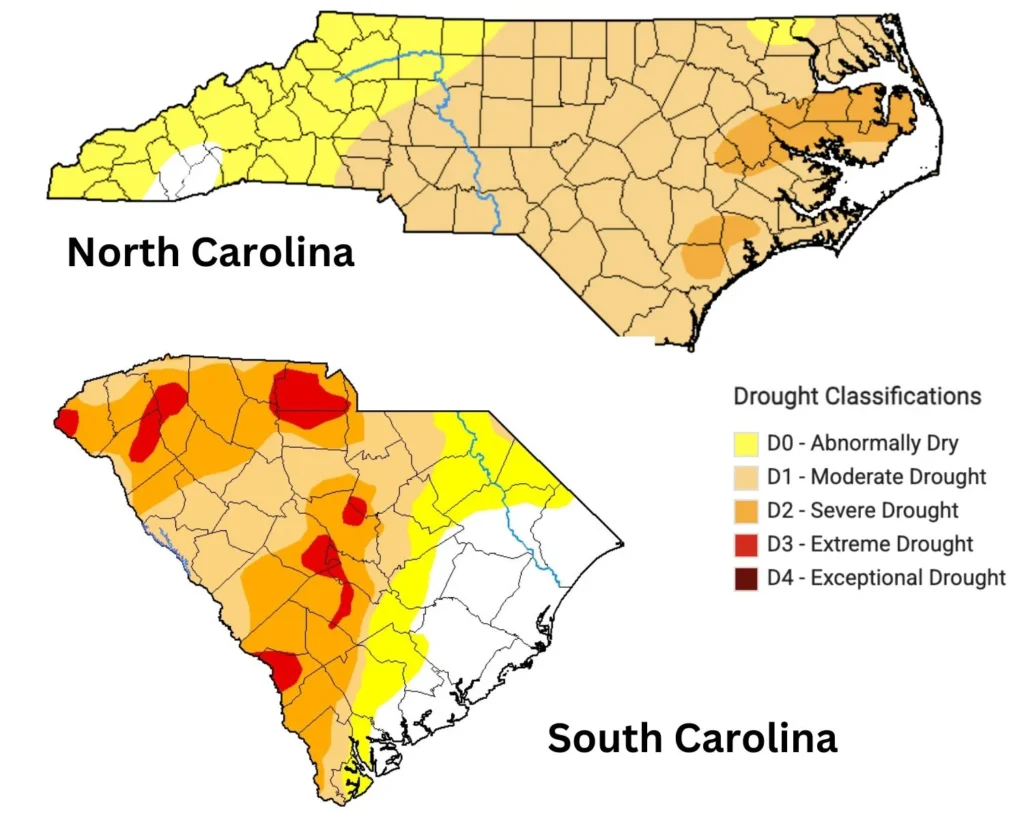Introduction
Wildfires in the Carolinas: In early March 2025, widespread wildfires erupted across North Carolina, South Carolina, and Georgia. A combination of strong winds, unseasonably dry conditions, and low humidity created the perfect storm for flames to ignite and spread. Experts from Wake Forest University weighed in on the contributing factors, providing valuable insights into the region’s fire patterns and climate trends. The fires followed a year of dramatic climate swings, illustrating how quickly conditions can shift from extreme flooding to fire-favorable dryness.
1. Persistent Drought Conditions
Since November 2024, much of the Carolinas has faced moderate drought or abnormally dry conditions. The extended lack of precipitation caused vegetation to dry out, turning forests and grasslands into fuel for wildfires. Once ignition occurs—whether from lightning or human activity—wind gusts accelerate fire spread. Experts emphasize that this persistent drought results from broader climate trends, with rising temperatures contributing to increased evaporation and drier soils, making wildfires more frequent and intense over time.

2. Weather Extremes Leading Up to the Fires
The Carolinas have experienced a volatile weather cycle over the past year. A flash drought in summer 2024 was followed by extreme flooding in September due to Tropical Storm Debby and Hurricane Helene. However, after the storms passed, rainfall remained scarce, causing the region to dry out again by winter 2025. This pattern of weather whiplash is becoming more common, with extreme shifts between wet and dry periods increasing the difficulty of predicting fire risk. Scientists warn that such rapid transitions leave little time for vegetation to recover, making ecosystems more susceptible to burning.
3. The Role of Wind and Low Humidity
Even under normal conditions, fire outbreaks can be exacerbated by wind and humidity levels. When humidity drops, the moisture in vegetation decreases, making plants more flammable. Strong winds then carry embers, allowing wildfires to jump from one area to another, increasing their intensity and range. In early March 2025, wind gusts of up to 40 mph were recorded in affected areas, making it nearly impossible to contain the flames. The interplay of these factors means that small fires can quickly become uncontrollable blazes, posing a significant threat to both wildlife and human populations.
4. The Southeast’s Natural Fire Cycles
Wildfires are not an anomaly in the Carolinas but rather a natural part of the ecosystem. Some plant species, such as Venus flytraps and pitcher plants, rely on periodic fires to clear competing vegetation and allow for growth. Certain wildlife also benefit from post-fire habitats that support native plant regrowth. However, the frequency and intensity of recent fires are raising concerns among ecologists. Human-induced climate change is disrupting traditional fire cycles, leading to more severe and unpredictable wildfire patterns. Additionally, fire suppression efforts over the past century have resulted in an unnatural buildup of flammable material, creating conditions for more destructive blazes.
5. Human Activities and Fire Risk

While natural conditions play a significant role in wildfire outbreaks, human activities also contribute to fire ignition and spread. Unattended campfires, discarded cigarette butts, and poorly managed land burns are common causes of wildfires in the region. As urban expansion continues, more communities are encroaching on fire-prone areas, increasing the likelihood of human-caused ignition. Fire officials emphasize the importance of responsible fire management practices, urging residents and visitors to adhere to local burn bans and take preventive measures to reduce accidental fires.
Outlook for the 2025 Fire Season
Although storms on March 5, 2025, helped contain some fires, the Southeast’s fire season is just beginning. With dry conditions persisting, additional outbreaks remain a concern. Experts continue to monitor weather patterns and advise communities on fire prevention strategies to mitigate future risks. Given the unpredictability of climate patterns, fire officials are increasing prescribed burns and fuel reduction efforts to minimize the risk of catastrophic wildfires. Residents are encouraged to prepare emergency plans and stay informed about changing fire conditions.
Conclusion
The 2025 wildfire outbreak in the Carolinas is a stark reminder of how climate patterns, droughts, and wind conditions intersect to influence fire activity. While wildfires are a natural occurrence in the region, understanding their causes can help improve preparedness and response efforts moving forward. With climate trends pointing toward continued shifts between extreme drought and heavy precipitation, proactive fire management strategies will be crucial in protecting both ecosystems and communities from future devastation.


